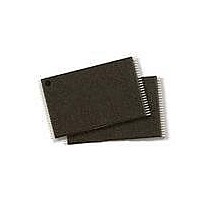S29JL032H70TFI020 Spansion Inc., S29JL032H70TFI020 Datasheet - Page 11

S29JL032H70TFI020
Manufacturer Part Number
S29JL032H70TFI020
Description
IC,EEPROM,NOR FLASH,2MX16/4MX8,CMOS,TSSOP,48PIN,PLASTIC
Manufacturer
Spansion Inc.
Datasheets
1.S29JL032H70TFI020.pdf
(66 pages)
2.S29JL032H70TFI020.pdf
(66 pages)
3.S29JL032H70TFI020.pdf
(64 pages)
4.S29JL032H70TFI020.pdf
(66 pages)
Specifications of S29JL032H70TFI020
Data Bus Width
8 bit, 16 bit
Architecture
Boot Sector
Interface Type
Conventional
Access Time
70 ns
Supply Voltage (max)
3.6 V
Supply Voltage (min)
2.7 V
Maximum Operating Current
2 mA
Mounting Style
SMD/SMT
Memory Type
Flash
Memory Size
32 Mbit
Operating Temperature
+ 85 C
Package / Case
TSOP-48
Lead Free Status / RoHS Status
Lead free / RoHS Compliant
Lead Free Status / RoHS Status
Lead free / RoHS Compliant
Available stocks
Company
Part Number
Manufacturer
Quantity
Price
Company:
Part Number:
S29JL032H70TFI020H
Manufacturer:
SPANSION
Quantity:
30
May 21, 2004 S29JL032HA0
Word/Byte Configuration
Requirements for Reading Array Data
Writing Commands/Command Sequences
The BYTE# pin controls whether the device data I/O pins operate in the byte or
word configuration. If the BYTE# pin is set at logic ‘1’, the device is in word con-
figuration, DQ15–DQ0 are active and controlled by CE# and OE#.
If the BYTE# pin is set at logic ‘0’, the device is in byte configuration, and only
data I/O pins DQ7–DQ0 are active and controlled by CE# and OE#. The data I/
O pins DQ14–DQ8 are tri-stated, and the DQ15 pin is used as an input for the
LSB (A-1) address function.
To read array data from the outputs, the system must drive the CE# and OE#
pins to V
control and gates array data to the output pins. WE# should remain at V
BYTE# pin determines whether the device outputs array data in words or bytes.
The internal state machine is set for reading array data upon device power-up,
or after a hardware reset. This ensures that no spurious alteration of the memory
content occurs during the power transition. No command is necessary in this
mode to obtain array data. Standard microprocessor read cycles that assert valid
addresses on the device address inputs produce valid data on the device data
outputs. Each bank remains enabled for read access until the command register
contents are altered.
Refer to the AC Read-Only Operations table for timing specifications and to 14 for
the timing diagram. I
rent specification for reading array data.
To write a command or command sequence (which includes programming data
to the device and erasing sectors of memory), the system must drive WE# and
CE# to V
For program operations, the BYTE# pin determines whether the device accepts
program data in bytes or words. Refer to “Word/Byte Configuration” for more
information.
The device features an Unlock Bypass mode to facilitate faster programming.
Once a bank enters the Unlock Bypass mode, only two write cycles are required
to program a word or byte, instead of four. The “Byte/Word Program Command
Sequence” section has details on programming data to the device using both
standard and Unlock Bypass command sequences.
An erase operation can erase one sector, multiple sectors, or the entire device.
Tables
“sector address” is the address bits required to uniquely select a sector. The
“Command Definitions” section has details on erasing a sector or the entire chip,
or suspending/resuming the erase operation.
The device address space is divided into four banks. A “bank address” is the ad-
dress bits required to uniquely select a bank.
I
the write mode. The AC Characteristics section contains timing specification ta-
bles and timing diagrams for write operations.
CC2
in the DC Characteristics table represents the active current specification for
3
and
IL
IL
A D V A N C E
. CE# is the power control and selects the device. OE# is the output
, and OE# to V
4
indicate the address space that each sector occupies. Similarly, a
CC1
in the DC Characteristics table represents the active cur-
IH
I N F O R M A T I O N
.
S29JL032H
IH
. The
11
















